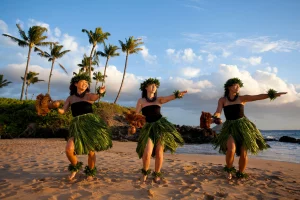What if we told you there was a place on Maui home to fire twirling nudists and hardened rivers of jet black lava that have scarred the windswept landscape. A place where you still need hiking boots to reach an isolated beach, which is set down a trail that was originally commissioned by 16th century kings?
What if we told you this coastal wilderness is just minutes from high-end resorts and is also packed full of white sand beaches that offer up Maui’s best sunsets?
Fall in Love With Ruggedly Beautiful Makena
Chances are you’d want to know more about this area known as Makena — a rugged, adventurous, outdoor playground on Maui’s southern coast.
Just ten minutes from Wailea, Makena is home to a smattering of condos and ultra-luxurious homes and could be the site of large-scale development taking place in the upcoming decade.
As it currently stands, however, much of Makena is still undeveloped and under-visited by tourists and remains the island’s best stretch of coast for active outdoor pursuits.
Check out “Turtle Town”
At Makena Landing and Maluaka Beach, protected coves create perfect conditions for snorkeling, paddling and kayaking and are home to canoeing and kayaking tours that cruise the rocky coast. More famously known as “Turtle Town,” the area is packed with Hawaiian Green sea turtles that live in underwater caves and occasionally surface to sip some air before swimming off into the blue.
Discover Beach Bliss
If you just want to find a long stretch of sand for soaking up some rays, head to “Big Beach” in Makena State Park, which aside from being one of Maui’s longest and widest beaches, still exists in its natural state, as it’s blissfully undeveloped. The other two beaches inside the park are black sand Oneuli Beach and “Little Beach,” which is officially Maui’s unofficial nude beach. To sample Makena’s other beaches, you can bask on the sands of Po‘olenalena and snorkel around the rocks or literally walk through a hole in the wall to emerge at pocket-sized Puako Cove, more commonly known as “Secret Beach.”
Get Windswept
Continue south from Makena State Park and the coastline truly gets wild, where the road at parts is a single lane that’s close enough to the crashing surf that waves can splash on your tires. Look to your left, away from the coast, and a frozen black river of lava flows down from a vent on the verdant green hillside, where in 1790 Haleakalā volcano experienced its last eruption.
Crossing the craggy black lava fields, the pavement finally comes to an end in windswept Keone‘o‘io, which is also known as La Perouse Bay since it’s here where the French explorer, Jean Francois de Galaup, comte de La Pérouse, became the very first European to set foot on Maui’s shore.
Walk the Ancient Trails
It’s also here where the trail begins for the ancient Hoapili Trail, a footpath built from lava rock that was commissioned by Governor Hoapili back in the 1830s. With its impressively long, straight stone walls, the trail is a testament to early Hawaiian strength and engineering and crosses narrower sections of trail that date all the way back to the 16th century when King Hoapili would use the path to circle the island on foot.
Swing Seaside to the Sound of Crashing Waves
Walk for two miles down the ancient stone trail and eventually you’ll reach the coral-strewn shore that makes up Kanaio Beach, where a swing that’s made out of driftwood hangs just inches away from the sea.
It isn’t the island’s most popular beach, and definitely not it’s most scenic, but there’s something invigorating about having a stretch of shoreline all to yourself, where the only sounds are the crash of the waves and the cooling rush of the wind.






